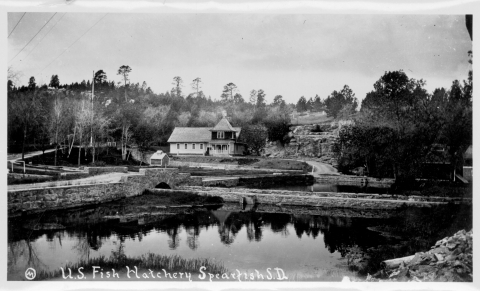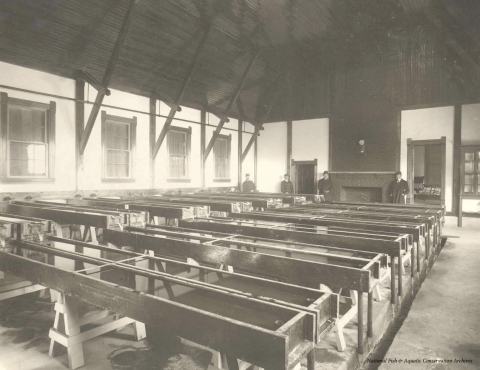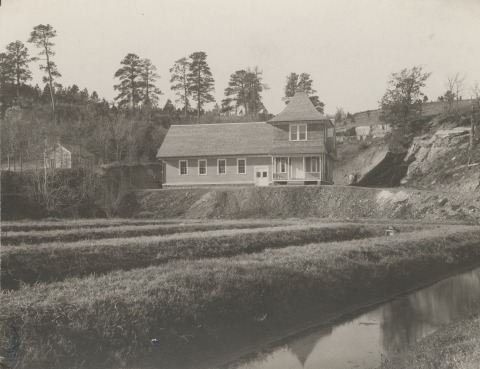About Us
Established in 1896, D.C. Booth Historic National Fish Hatchery and Archives, formerly Spearfish National Fish Hatchery, is one of the oldest operating hatcheries in the country. Dedicated to fish culture and resource management, the hatchery was constructed to propagate, stock, and establish trout populations in the Black Hills of South Dakota and Wyoming.
Still rearing trout for tribal waters through cooperative efforts, the hatchery is also has a museum, multiple historic structures to tour and is on the National Register of Historic Places. Additionally, the hatchery houses the National Fish & Aquatic Conservation Archives that serves to protect and preserve our nation’s fishery records and artifacts for educational, research, and historic purposes. With over 180,000 visitors and 14,000 volunteer hours annually, the facility also strives to provide interpretive and educational programs for the public.
Our Mission
D.C. Booth Historic National Fish Hatchery and Archives is dedicated to fish culture and resource management. The station currently produces trout for recreational fishing on tribal lands in South Dakota and Eastern Montana and regional military waters. Listed on the National Historic Register, the hatchery’s mission and partnerships strive to preserve the U.S. Fish and Wildlife Service’s historic and cultural heritage for educational, research, and historical purposes and provide interpretive and educational programs to the public.
Since 1871, National Fish Hatcheries have been applying science-based approaches to conservation challenges. We work with our partners and engage the public to conserve, restore, and enhance fish and other aquatic resources for the continuing benefit of the American people. Conservation is at the heart of what we do, and we recognize that we do this work for the American people–both the present generation who benefit today and future generations who will inherit our legacy of conserving America’s aquatic resources.
Our History
In the early 1890s, a bill introduced in the United States Senate by South Dakota Senator R.F. Pettigrew, appropriated $500 for investigating the possibility of placing a fish culture station in Nebraska, Wyoming, Montana, or the Dakotas.
Dr. B.W. Evermann headed a detail to undertake investigation of water resources in the area. Several localities in South Dakota were examined for their suitability. Spearfish was finally chosen because of the relative abundance of pure, cold spring water available for a gravity system and its accessibility to the town and regions railroad system. These favorable reports led to an initial appropriation of $5,000 by Congress on June 11, 1896, to establish a fish culture station in the Black Hills at Spearfish, South Dakota.
Land was purchased June 10, 1898, at the entrance to Ames Canyon on the southern boundary of the City of Spearfish. J. H. Russell Construction Company of Spearfish bid $5,995 for the construction of the hatchery building and icehouse. By July 1, 1899, the contractor had nearly completed his work and seventeen fishponds were nearly ready to receive fish. Mr. D.C. Booth was appointed superintendent of the hatchery. The fish hatchery building and icehouse were formally accepted by the government on July 25, 1899.
A view of the hatching room in the hatchery building in 1899. Credit: USFWS National Fish & Aquatic Conservation Archives.
As completed, the hatchery building was 66 feet long by 30 feet wide, a frame structure built upon a stone foundation. It contained a hatching room, office, reception hall, and boiler room on the first floor, with two bedrooms and closets on the second floor. The hatching room contained 48 hatching troughs fitted with trays and was able to handle two million trout eggs.
Raceways and ponds were constructed on the slope south of the hatchery building. Ponds 1-8 (constructed in 1899) were native pine on the sides with earth-filled bottoms. Ponds 9-12 (1900) were lined with cypress. Ponds 13-16 were merely excavated, having earth bottoms and sides. Ponds 18-20 were excavated with lime-stone walls. Ponds 21-24 (1913) were constructed of cement with earth bottoms. Other buildings included the icehouse (capacity of 35 tons of ice), a one-story frame structure that had two rooms for employee quarters, a barn, and an annex for the barn (including a workshop) and structures to cover hydraulic pumps.
The hatchery building and ponds were supplied by pure spring water rising on the reservation. The normal average temperature of the water was very favorable for egg incubation. The springs were located at sufficient elevation to provide a gravity system for distribution, conducted through a nine-inch iron pipe provided with brass valves at each pond and hatching trough.
D.C. Booth hatchery building in 1899. Credit: USFWS National Fish & Aquatic Conservation Archives.
Shortly after completion of the hatchery building, a telegram was received from the Assistant Fish Commissioner in Washington, D.C., asking how soon the station would be ready to receive a shipment of trout eggs. The superintendent wired that the hatchery would be ready to receive eggs at any time. The hatchery crew set to work making hatchery trays, building supply troughs, installing faucets and turning on the spring water for the first shipment. By July 29, 1899, 100,000 trout eggs were in the process of incubation.
The hatchery site, located at the lower end of a mountain canyon, previously housed a sawmill that operated on the grounds with adjoining cook shacks, bunk houses, stables, blacksmith shop, lumber piles, refuse and sawdust that interfered with hatchery operations. Shortly after eggs were placed in the hatchery troughs in July 1899, a rainstorm occurred, washing down tons of sawdust, horse manure, tin cans, rock, lumber, and other refuse. The refuse filled the spring reservoir supplying the hatchery building and deposited several inches of sediment in all the ponds and hatching troughs. After this experience, storm channels, bridges and bulkheads were constructed out of limestone rock and cement to prevent future flooding. Many are still in use today.
A residence for the Superintendent and his family was constructed in 1905. It is a two-story frame home with a stone basement, eight rooms, and a bath with hot water radiation heating.
In 1901, the Spearfish National Fish Hatchery began to operate an egg-gathering substation in Yellowstone National Park. Located on the West Thumb of Yellowstone Lake, the substation was mainly responsible for the collection of black-spotted trout eggs (cutthroat trout) and their subsequent shipment to Spearfish for hatching and later distribution to other areas.
Since direct railroad service did not exist between Spearfish and Yellowstone Lake, an overland expedition was undertaken each year to gather the eggs and return them to Spearfish. The expedition usually left Spearfish in June, traveling by rail as far as possible to Gardiner, MT. The last portion of the journey was made by wagon, with the wagons piled high with boats, nets, troughs, and other equipment. The annual Yellowstone expeditions were conducted from 1901-1911. At that time, the hatchery at Bozeman, Montana, assumed responsibility for the Yellowstone egg-gathering and hatching operations.
Originally established as a subsidiary hatchery to Leadville, Colorado, the Spearfish National Fish Hatchery later became headquarters for federal fisheries operations in the Western United States, correlating activities at several other hatchery stations scattered through the West.
By the 1940s, the water supply at Spearfish had become increasingly undependable. This resulted in the acquisition of land 12 miles west of Spearfish from Judge McNenny and the State of South Dakota to rear fish. In 1949, a new hatchery was constructed and named the McNenny National Fish Hatchery. Between the McNenny and Spearfish National Fish Hatcheries, nearly one million fish were produced annually. The Spearfish center became a training academy for fish culture courses and a center for fish nutrition or diet development.
Ranch A, in Sand Creek Canyon, Wyoming, was acquired by the federal government in 1963 for development as a Fish Genetics Laboratory, a satellite operation of the Service's fish cultural research facility at Leetown, West Virginia. After transfer of the Genetics Lab to Leetown in 1979, Ranch A became part of the Spearfish Fisheries Center Complex and the new home of the Diet Development Center, previously housed at McNenny.
During severe budget constraints in the early 1980s, McNenny NFH was transferred to the State of South Dakota and the Spearfish hatchery was closed. Ranch A ceased operations in 1986. Although not in operation, the FWS retained ownership of Ranch A and the Spearfish hatchery. The City of Spearfish requested permission to operate the hatchery under an agreement with the FWS. Operations of the hatchery began again in 1984 with the City renaming the hatchery after its first superintendent, DeWitt Clinton "D.C." Booth.
In 1989, Congress appropriated funding for construction of a state of the art museum property storage building, public restrooms, concession, and underwater viewing area at D.C. Booth with the FWS resuming operations of the facility with a new mission to "assemble, preserve, protect, make accessible to researchers, and interpret the history and technology of fish culture". The Ranch A facility was transferred to the State of Wyoming in 1997 along with historic furniture and artifacts original to the site.
Today, the FWS continues to fully own and operate the D.C. Booth fish hatchery and produces trout for recreational fishing on tribal lands in South Dakota and Eastern Montana and regional military waters. D.C. Booth partners with multiple organizations for enhanced visitor services including the City of Spearfish and the hatchery's friends group, the Booth Society. Over 180,000 people visit the hatchery each year to learn about fisheries, enjoy the grounds and feed the fish.
Other Facilities in this Complex
National Fish and Aquatic Conservation Archives
The mission of the National Fish and Aquatic Conservation Archives (NFACA) is to assemble, preserve, protect, interpret and make accessible to researchers the history and technology of the federal fisheries program. The bulk of the collection focuses on the history of fish culture, fisheries management, the U.S. Fish Commission, U.S. Bureau of Fisheries, National Fish Hatchery System and the overall history of the U.S. Fish and Wildlife Service. The 10,000 square foot Arden Trandahl Collection Management Facility serves as a Department of the Interior standards compliant archival center.





